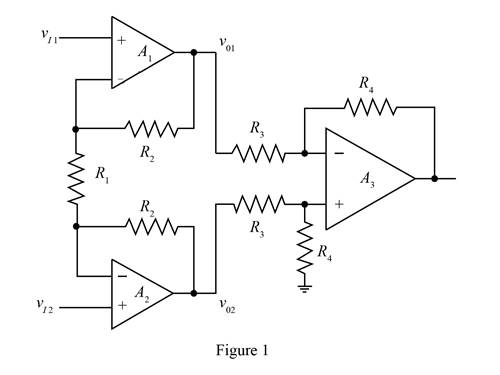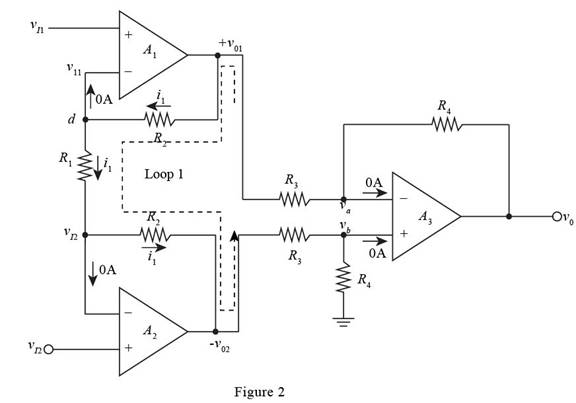
Concept explainers
Assume the instrumentation amplifier in Figure 9.26 has ideal op-amps. Thecircuit parameters are
(a)
The values of the voltages
Also, the current through the resistance
Answer to Problem 9.67P
The expression for the voltage
Explanation of Solution
Calculation:
The given diagram is shown in Figure 1

Mark the voltages and current and redraw the circuit.
The required diagram is shown in Figure 2

The expression for the voltage
The expression for the current at the node
Substitute
Apply KCL at the node
Substitute
Substitute
The expression for the current
Apply KVL in the loop 1
Substitute
Substitute
Substitute
Substitute
Substitute
The expression for the current
Substitute
The expression for the voltage
Substitute
Conclusion:
Therefore, theexpression for the voltage
(b)
The values of the voltages
Also the current through the resistance
Answer to Problem 9.67P
The expression for the voltage
Explanation of Solution
Calculation:
Substitute
Substitute
Substitute
Substitute
Conclusion:
Therefore, the expression for the voltage
Want to see more full solutions like this?
Chapter 9 Solutions
Microelectronics: Circuit Analysis and Design
- Figure 1 shows the equivalent circuit of a voltage amplifier with a source and aload connected to its input and output, respectively. Suppose that the sourceinternal resistance is Rs = 5 kΩ, the amplifier input resistance is RIN = 95 kΩ, theamplifier gain is A = 100, the amplifier output resistance is ROUT = 150 Ω and theload resistance is RL = 5 kΩ. For a sinusoidal input with amplitude VS = 5 mV, whatis the amplitude of the voltage VL across the load resistor RL? What would thevoltage across the load be without the amplifier?arrow_forwardSuppose we have a voltage source v(t)=Vdc+Vm cos(ωt) connected to the input terminals of an amplifier. The load is a nonlinear device such as an LED. a. What output impedance is needed for the amplifier if we need the current through the load to be proportional to v(t)? b. If we need the voltage across the load to be proportional to v(t)?arrow_forwardSubject : ELECTRONIC CIRCUIT ANALYSIS AND DEVICES Please give the DC ANALYSIS CIRCUIT and AC EQUIVALENT CIRCUIT of this problem before proceeding to find letter c. (Note : Neglect Vbe)arrow_forward
- (attached picture) In the circuit in the figure maximum power transfer theorem ? r1 resistance?,r2 resistance?, c condanser?,l capacitor?arrow_forwardReferring to the unity-feedback control system defined by: A. Find the following requirements in plotting the root locus. number of branches number of asymptotes asymptote real-axis intercept asymptote line angles real-axis break-away points / break-in points points at the jw-crossing B. Manually plot the root locus based on the requirements from item A C. Create a Matlab m-file to verify your root locus plot. Write down the Matlab code belowarrow_forward3D Problem 1. (P1) Three op-amps are connected in cascade configuration. An 80 microVolts signal is connected to the non-inverting input of the first op-amp. Both the 2nd and 3rd op-amps operates as inverting amplifiers. All feedback resistors are 420 KOhms while the input resistances are 71.4kOhms, 19.1kOhms, and 14KOhms respectively. Determine the output of the third stage stage. a.9 V b.9000 mV c.79.2 V d.792 mVarrow_forward
- Subject: control Discuss the effect of adding a zero on the root locus shape, through the relative stability.arrow_forwardDesign an amplifier circuit using OPAMP with vo= (5*v1)+(v2)+(3*v3)-(2*v4). Draw vo knowing that v1 = 1 sin (1000*pi*t), v2 = 2 sin (2000*pi*t), v3 = 3sin (3000*pi*t), v4 = 4 sin (4000*pi*t)arrow_forwardDesign V0 = 9V1 +7 V2 -2 V3 Constraints: Use 2 Op-Ampsarrow_forward
- Based on the op amp circuit in Figure, answer the following questions,assuming an ideal op-amp. Given:V1 = 1 VI2 = 2 mAV3 = 0.5 VRa = 2 kΩRb = 1 kΩRc = 5 kΩRd = 10 kΩ Determine the voltage Vx, and the current Ib through Rbarrow_forwardDesign a two stage summer that has an output voltage given by Vout = 2 Vin1 - 5Vin2 + 0.2Vin3 - 0.5Vin4 let Rf1 = 2 kN and Rf2 = 5 kN .arrow_forwardFigure 1 shows a well-known circuit configuration with the bypassed source resistor using an n-channel D-MOSFET with yos = 20µS. (iv) Calculate transconductance, gm and rd. (v) Calculate the input, Zi and output impedance, Zo for the circuit. (vi) Prove that the equation for the no-load Gain, AvNL, for the circuit is as follows: AvNL = -gm (RD X rd / RD + rd) (vii) Calculate the no-load gain AVNL. (viii) Find the value of VoNL if Vi = 30 mV.arrow_forward
 Introductory Circuit Analysis (13th Edition)Electrical EngineeringISBN:9780133923605Author:Robert L. BoylestadPublisher:PEARSON
Introductory Circuit Analysis (13th Edition)Electrical EngineeringISBN:9780133923605Author:Robert L. BoylestadPublisher:PEARSON Delmar's Standard Textbook Of ElectricityElectrical EngineeringISBN:9781337900348Author:Stephen L. HermanPublisher:Cengage Learning
Delmar's Standard Textbook Of ElectricityElectrical EngineeringISBN:9781337900348Author:Stephen L. HermanPublisher:Cengage Learning Programmable Logic ControllersElectrical EngineeringISBN:9780073373843Author:Frank D. PetruzellaPublisher:McGraw-Hill Education
Programmable Logic ControllersElectrical EngineeringISBN:9780073373843Author:Frank D. PetruzellaPublisher:McGraw-Hill Education Fundamentals of Electric CircuitsElectrical EngineeringISBN:9780078028229Author:Charles K Alexander, Matthew SadikuPublisher:McGraw-Hill Education
Fundamentals of Electric CircuitsElectrical EngineeringISBN:9780078028229Author:Charles K Alexander, Matthew SadikuPublisher:McGraw-Hill Education Electric Circuits. (11th Edition)Electrical EngineeringISBN:9780134746968Author:James W. Nilsson, Susan RiedelPublisher:PEARSON
Electric Circuits. (11th Edition)Electrical EngineeringISBN:9780134746968Author:James W. Nilsson, Susan RiedelPublisher:PEARSON Engineering ElectromagneticsElectrical EngineeringISBN:9780078028151Author:Hayt, William H. (william Hart), Jr, BUCK, John A.Publisher:Mcgraw-hill Education,
Engineering ElectromagneticsElectrical EngineeringISBN:9780078028151Author:Hayt, William H. (william Hart), Jr, BUCK, John A.Publisher:Mcgraw-hill Education,





